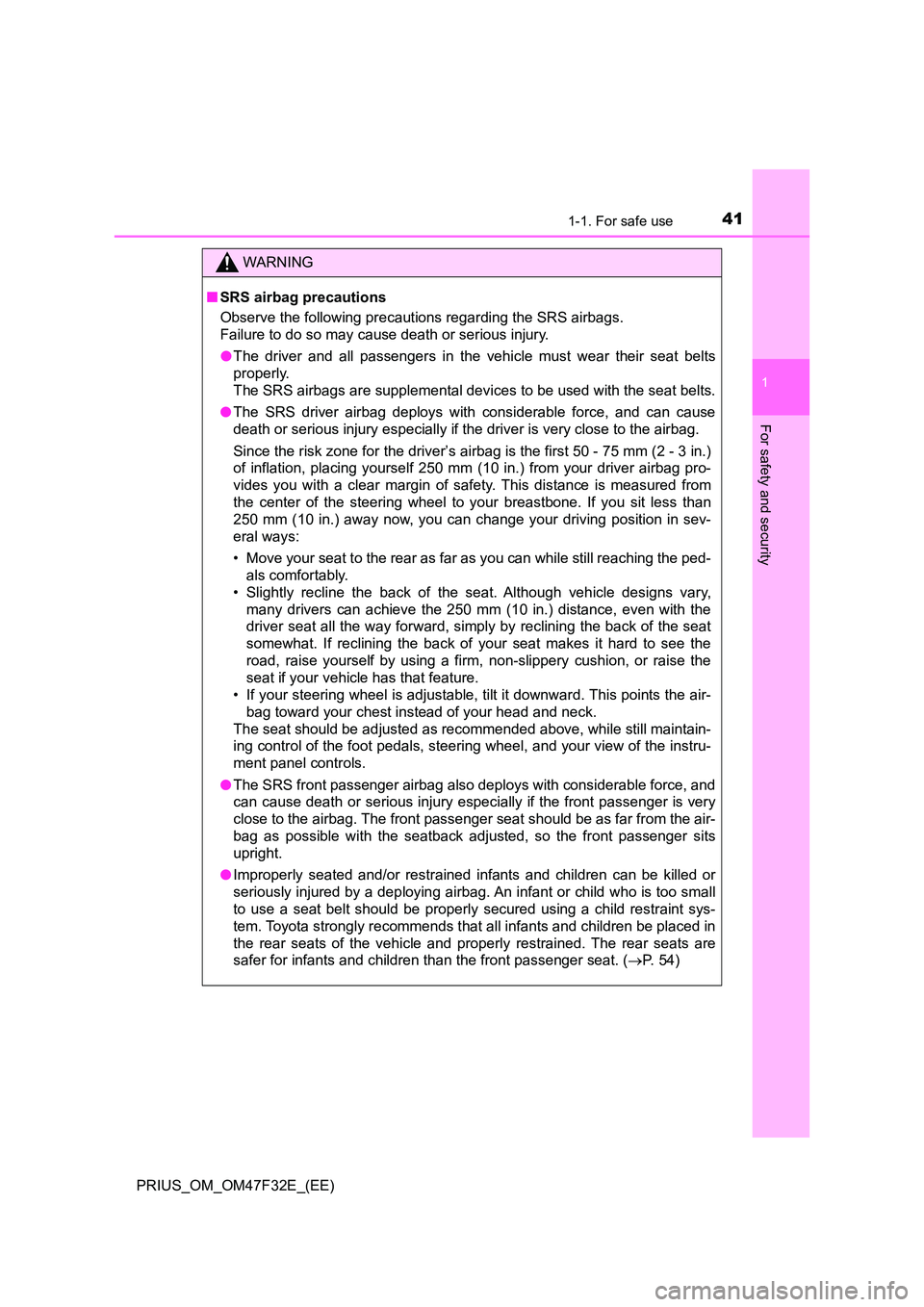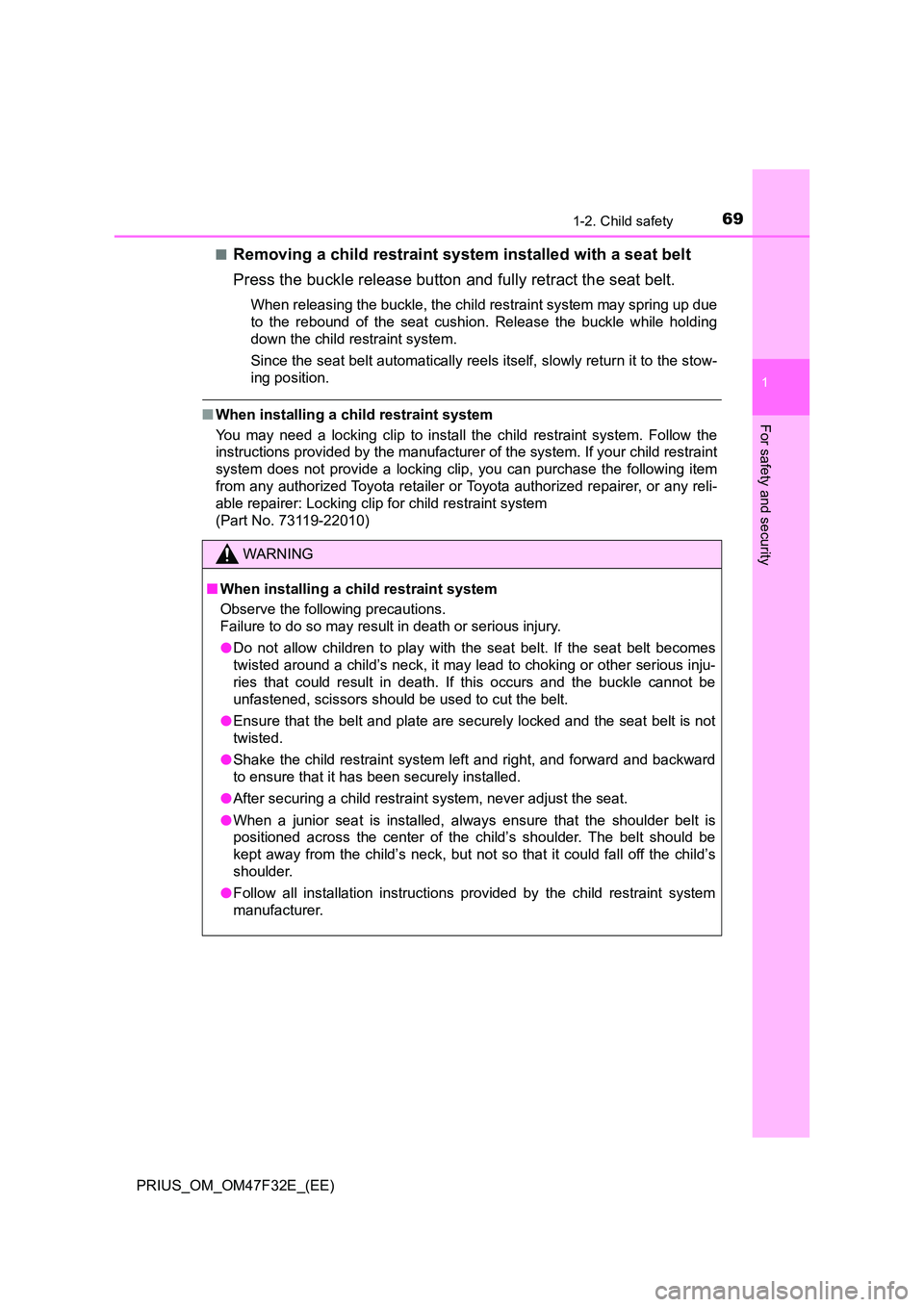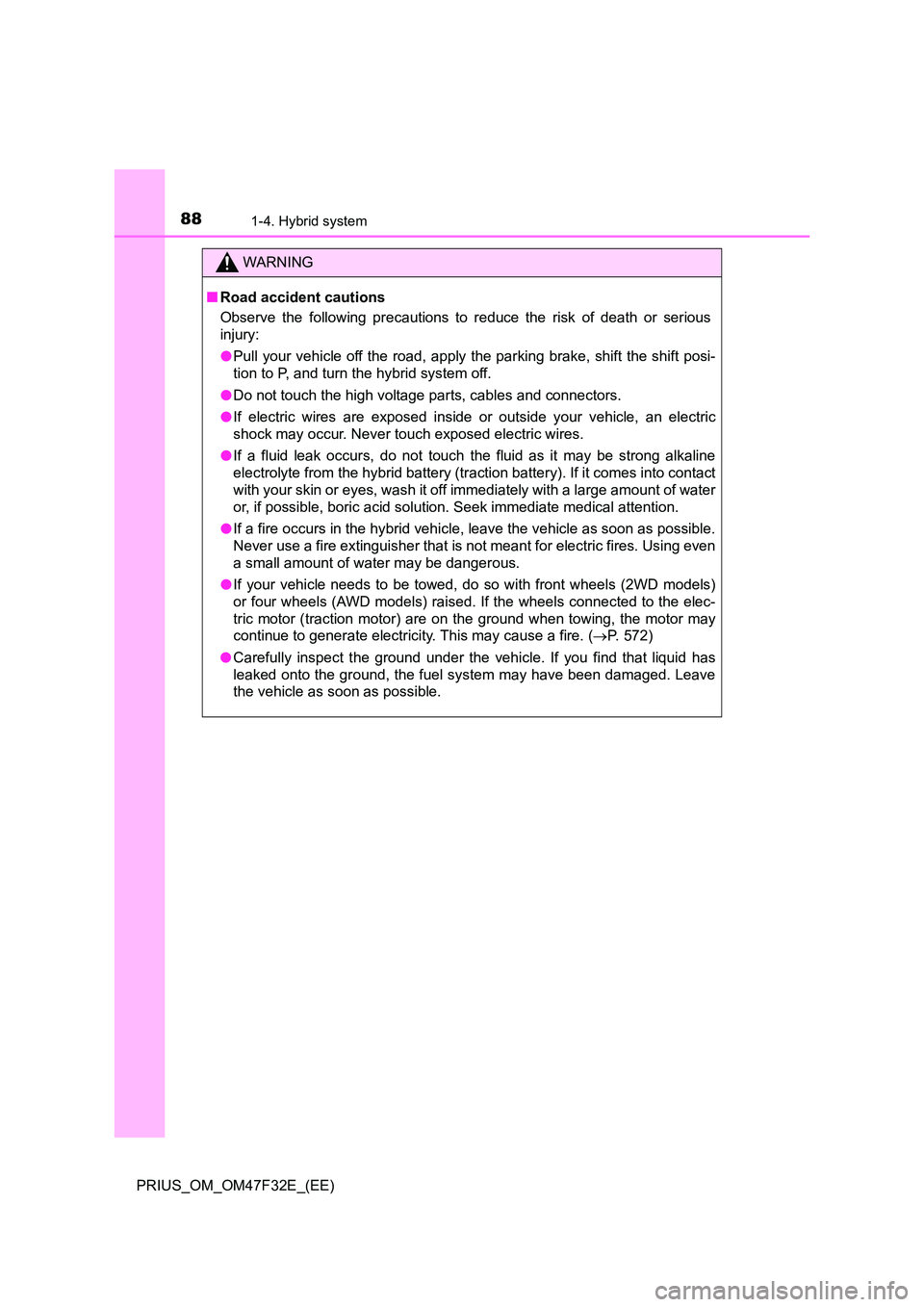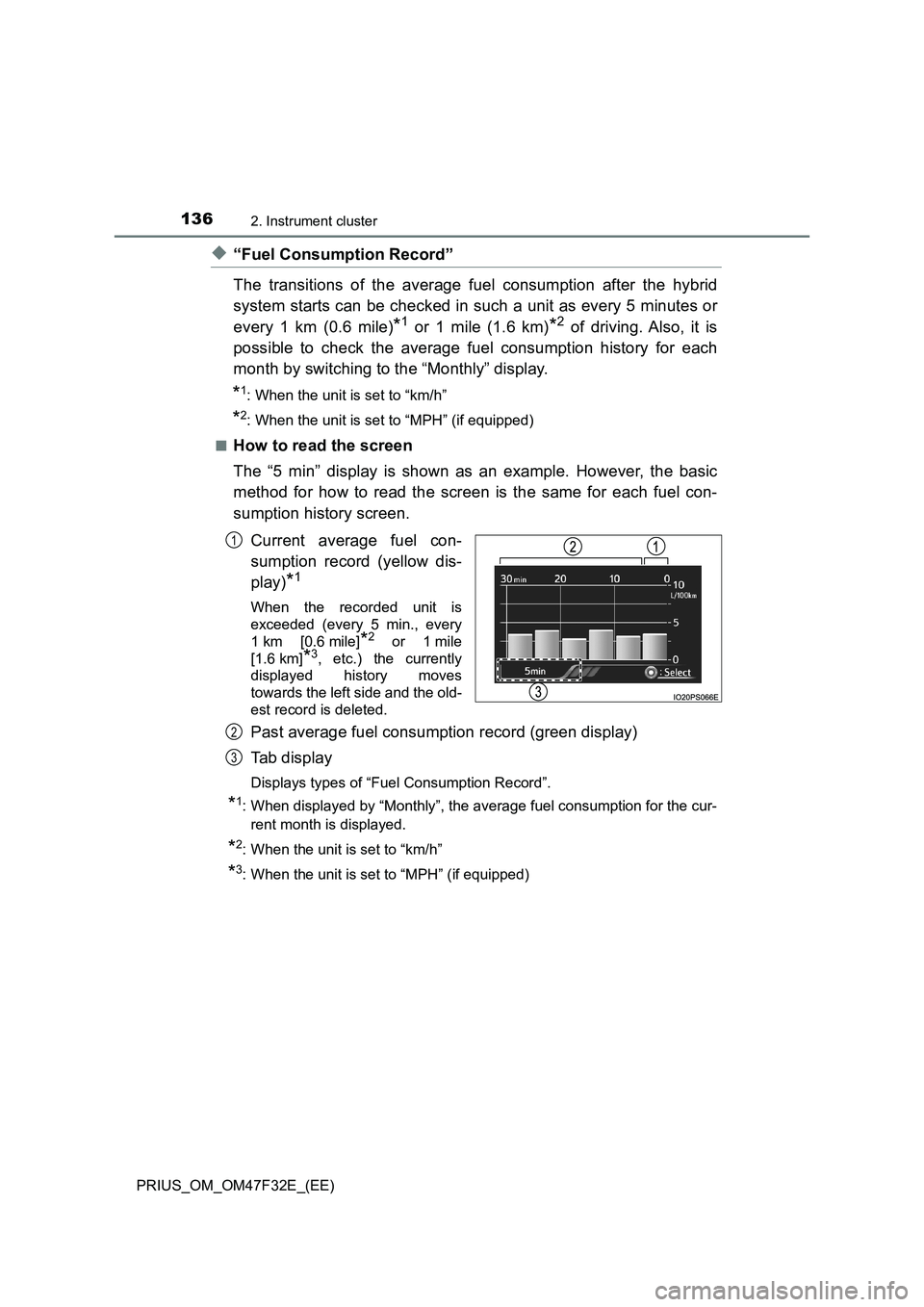tow TOYOTA PRIUS 2023 Owners Manual
[x] Cancel search | Manufacturer: TOYOTA, Model Year: 2023, Model line: PRIUS, Model: TOYOTA PRIUS 2023Pages: 770, PDF Size: 122.55 MB
Page 5 of 770

3
1
8
7
6
5
4
3
2
PRIUS_OM_OM47F32E_(EE)
4-1. Before driving
Driving the vehicle .............220
Cargo and luggage ............231
Trailer towing
(2WD models)..................233
Trailer towing
(AWD models) .................243
4-2. Driving procedures
Power (ignition) switch .......244
EV drive mode ...................250
Hybrid transmission ...........253
Turn signal lever ................259
Parking brake.....................260
4-3. Operating the lights
and wipers
Headlight switch.................261
AHB (Automatic High
Beam) ..............................266
Fog light switch ..................270
Windshield wipers and
washer .............................271
Rear window wiper and
washer .............................275
4-4. Refueling
Opening the fuel tank
cap ...................................277
4-5. Using the driving
support systems
Toyota Safety Sense ......... 282
PCS (Pre-Collision
System) ........................... 296
LTA
(Lane Tracing Assist) ...... 307
RSA (Road Sign Assist) .... 323
Dynamic radar cruise
control with full-speed
range ............................... 329
Cruise control .................... 346
Driving mode select
switch .............................. 351
Speed limiter ..................... 353
BSM
(Blind Spot Monitor) ........ 356
• The Blind Spot Monitor
function ......................... 372
• The Rear Crossing
Traffic Alert function ...... 375
Toyota parking
assist-sensor ................... 381
Parking Support Brake
function ........................... 394
S-IPA (Simple Intelligent
Parking Assist
System) ........................... 405
GPF (Gasoline Particulate
Filter) system .................. 440
Driving assist systems....... 441
4-6. Driving tips
Hybrid vehicle driving
tips .................................. 449
Winter driving tips.............. 452
4Driving
Page 7 of 770

5
1
8
7
6
5
4
3
2
PRIUS_OM_OM47F32E_(EE)
7-1. Essential information
Emergency flashers ...........568
If your vehicle has to
be stopped in an
emergency .......................569
If the vehicle is submerged
or water on the road is
rising ................................570
7-2. Steps to take in an
emergency
If your vehicle needs
to be towed ......................572
If you think something is
wrong ...............................579
If a warning light turns on
or a warning buzzer
sounds .............................580
If a warning message is
displayed .........................589
If you have a flat tire
(vehicles without
spare tire) ........................598
If you have a flat tire
(vehicles with
spare tire) ........................618
If the hybrid system will
not start............................634
If the electronic key does
not operate properly ........636
If the 12-volt battery is
discharged .......................639
If your vehicle
overheats .........................645
If the vehicle becomes
stuck ................................650
8-1. Specifications
Maintenance data
(fuel, oil level, etc.) .......... 654
Fuel information ................ 668
8-2. Customization
Customizable features ...... 670
8-3. Initialization
Items to initialize................ 679
7When trouble arises8Vehicle specifications
Page 18 of 770

16Pictorial index
PRIUS_OM_OM47F32E_(EE)
■Instrument panel (Left-hand drive vehicles)
Power switch . . . . . . . . . . . . . . . . . . . . . . . . . . . . . . . . . . . . . P. 244
Starting the hybrid system/changing the modes . . . . . . . . . . . P. 244
Emergency stop of the hybrid system . . . . . . . . . . . . . . . . . . . P. 569
When the hybrid system will not start . . . . . . . . . . . . . . . . . . . P. 634
Warning messages . . . . . . . . . . . . . . . . . . . . . . . . . . . . . . . . . P. 589
Shift lever . . . . . . . . . . . . . . . . . . . . . . . . . . . . . . . . . . . . . . . . P. 253
Changing the shift position . . . . . . . . . . . . . . . . . . . . . . . . . . . P. 253
Precautions against towing . . . . . . . . . . . . . . . . . . . . . . . . . . . P. 572
P position switch . . . . . . . . . . . . . . . . . . . . . . . . . . . . . . . . . . P. 254
Meters . . . . . . . . . . . . . . . . . . . . . . . . . . . . . . . . . . . . . . . . . . . P. 100
Reading the meters/adjusting the instrument
cluster light . . . . . . . . . . . . . . . . . . . . . . . . . . . . . . . . . . . P. 100, 102
Warning lights/indicator lights . . . . . . . . . . . . . . . . . . . . . . . . . P. 110
When the warning lights come on . . . . . . . . . . . . . . . . . . . . . . P. 580
1
2
3
4
Page 24 of 770

22Pictorial index
PRIUS_OM_OM47F32E_(EE)
■Instrument panel (Right-hand drive vehicles)
Power switch . . . . . . . . . . . . . . . . . . . . . . . . . . . . . . . . . . . . . P. 244
Starting the hybrid system/changing the modes . . . . . . . . . . . P. 244
Emergency stop of the hybrid system . . . . . . . . . . . . . . . . . . . P. 569
When the hybrid system will not start . . . . . . . . . . . . . . . . . . . P. 634
Warning messages . . . . . . . . . . . . . . . . . . . . . . . . . . . . . . . . . P. 589
Shift lever . . . . . . . . . . . . . . . . . . . . . . . . . . . . . . . . . . . . . . . . P. 253
Changing the shift position . . . . . . . . . . . . . . . . . . . . . . . . . . . P. 253
Precautions against towing . . . . . . . . . . . . . . . . . . . . . . . . . . . P. 572
P position switch . . . . . . . . . . . . . . . . . . . . . . . . . . . . . . . . . . P. 254
Meters . . . . . . . . . . . . . . . . . . . . . . . . . . . . . . . . . . . . . . . . . . . P. 100
Reading the meters/adjusting the instrument
cluster light . . . . . . . . . . . . . . . . . . . . . . . . . . . . . . . . . . . P. 100, 102
Warning lights/indicator lights . . . . . . . . . . . . . . . . . . . . . . . . . P. 110
When the warning lights come on . . . . . . . . . . . . . . . . . . . . . . P. 580
1
2
3
4
Page 43 of 770

411-1. For safe use
1
PRIUS_OM_OM47F32E_(EE)
For safety and security
WARNING
■SRS airbag precautions
Observe the following precautions regarding the SRS airbags.
Failure to do so may cause death or serious injury.
● The driver and all passengers in the vehicle must wear their seat belts
properly.
The SRS airbags are supplemental devic es to be used with the seat belts.
● The SRS driver airbag deploys with considerable force, and can cause
death or serious injury especially if the driver is very close to the airbag.
Since the risk zone for the driver’s airbag is the first 50 - 75 mm (2 - 3 in.)
of inflation, placing yourself 250 mm ( 10 in.) from your driver airbag pro-
vides you with a clear margin of safety. This distance is measured from
the center of the steering wheel to your breastbone. If you sit less than
250 mm (10 in.) away now, you can change your driving position in sev-
eral ways:
• Move your seat to the rear as far as you can while still reaching the ped-
als comfortably.
• Slightly recline the back of the seat. Although vehicle designs vary,
many drivers can achieve the 250 mm (10 in.) distance, even with the
driver seat all the way forward, simply by reclining the back of the seat
somewhat. If reclining the back of your seat makes it hard to see the
road, raise yourself by using a firm, non-slippery cushion, or raise the
seat if your vehicle has that feature.
• If your steering wheel is adjustable, tilt it downward. This points the air-
bag toward your chest instead of your head and neck.
The seat should be adjusted as recommended above, while still maintain-
ing control of the foot pedals, steering wheel, and your view of the instru-
ment panel controls.
● The SRS front passenger airbag also deploys with considerable force, and
can cause death or serious injury especially if the front passenger is very
close to the airbag. The front passenger seat should be as far from the air-
bag as possible with the seatback adjusted, so the front passenger sits
upright.
● Improperly seated and/or restrained infants and children can be killed or
seriously injured by a deploying airbag. An infant or child who is too small
to use a seat belt should be properly secured using a child restraint sys-
tem. Toyota strongly recommends that all infants and children be placed in
the rear seats of the vehicle and proper ly restrained. The rear seats are
safer for infants and children than the front passenger seat. ( P. 54)
Page 44 of 770

421-1. For safe use
PRIUS_OM_OM47F32E_(EE)
WARNING
■SRS airbag precautions
●Do not sit on the edge of the seat or
lean against the dashboard.
● Do not allow a child to stand in front of
the SRS front passenger airbag unit or
sit on the knees of a front passenger.
● Do not allow the front seat occupants to
hold items on their knees.
● Do not lean against the door, the roof
side rail or the front, side and rear pil-
lars.
● Do not allow anyone to kneel on the
passenger seat toward the door or put
their head or hands outside the vehicle.
Page 71 of 770

691-2. Child safety
1
PRIUS_OM_OM47F32E_(EE)
For safety and security
■Removing a child restraint system installed with a seat belt
Press the buckle release button and fully retract the seat belt.
When releasing the buckle, the chil d restraint system may spring up due
to the rebound of the seat cushion. Release the buckle while holding
down the child restraint system.
Since the seat belt automatically reels itself, slowly return it to the stow-
ing position.
■ When installing a child restraint system
You may need a locking clip to install the child restraint system. Follow the
instructions provided by the manufacturer of the system. If your child restraint
system does not provide a locking clip, you can purchase the following item
from any authorized Toyota retailer or Toyota authorized repairer, or any reli-
able repairer: Locking clip for child restraint system
(Part No. 73119-22010)
WARNING
■ When installing a child restraint system
Observe the following precautions.
Failure to do so may result in death or serious injury.
● Do not allow children to play with the seat belt. If the seat belt becomes
twisted around a child’s neck, it may lead to choking or other serious inju-
ries that could result in death. If this occurs and the buckle cannot be
unfastened, scissors should be used to cut the belt.
● Ensure that the belt and plate are securely locked and the seat belt is not
twisted.
● Shake the child restraint system left and right, and forward and backward
to ensure that it has been securely installed.
● After securing a child restraint system, never adjust the seat.
● When a junior seat is installed, always ensure that the shoulder belt is
positioned across the center of the child’s shoulder. The belt should be
kept away from the child’s neck, but not so that it could fall off the child’s
shoulder.
● Follow all installation instructions provided by the child restraint system
manufacturer.
Page 90 of 770

881-4. Hybrid system
PRIUS_OM_OM47F32E_(EE)
WARNING
■Road accident cautions
Observe the following precautions to reduce the risk of death or serious
injury:
● Pull your vehicle off the road, apply the parking brake, shift the shift posi-
tion to P, and turn the hybrid system off.
● Do not touch the high voltage parts, cables and connectors.
● If electric wires are exposed inside or outside your vehicle, an electric
shock may occur. Never touch exposed electric wires.
● If a fluid leak occurs, do not touch the fluid as it may be strong alkaline
electrolyte from the hybrid battery (traction battery). If it comes into contact
with your skin or eyes, wash it off immediately with a large amount of water
or, if possible, boric acid solution. Seek immediate medical attention.
● If a fire occurs in the hybrid vehicle, leave the vehicle as soon as possible.
Never use a fire extinguisher that is not meant for electric fires. Using even
a small amount of water may be dangerous.
● If your vehicle needs to be towed, do so with front wheels (2WD models)
or four wheels (AWD models) raised. If the wheels connected to the elec-
tric motor (traction motor) are on the ground when towing, the motor may
continue to generate electricity. This may cause a fire. ( P. 572)
● Carefully inspect the ground under the vehicle. If you find that liquid has
leaked onto the ground, the fuel system may have been damaged. Leave
the vehicle as soon as possible.
Page 132 of 770

1302. Instrument cluster
PRIUS_OM_OM47F32E_(EE)
◆Energy monitor
The energy monitor can be used to check the vehicle drive status,
hybrid system operation status and energy regeneration status.
When energy is flowing, an arrow appears and a bright point of light
moves to show the direction of the flow of energy. When energy is
not flowing, the bright point of light is not displayed.
Gasoline engine
Electric motor
(traction motor)
Hybrid battery
(traction battery)
Tire
Bright point of light showing
the flow of energy
As an example, all arrows are shown in the illustration, but the actual con-
tents of the display will differ.
(Display example)
●When the hybrid battery (traction battery) is being charged, the
bright point of light moves towards .
●During driving, the bright point of light moves from or (or
both depending on the situation) towards .
*
●During driving, the image of the tires rotates.
*: The display may differ depending on the driving status.
1
2
3
4
5
3
12
4
Page 138 of 770

1362. Instrument cluster
PRIUS_OM_OM47F32E_(EE)
◆“Fuel Consumption Record”
The transitions of the average fuel consumption after the hybrid
system starts can be checked in such a unit as every 5 minutes or
every 1 km (0.6 mile)
*1 or 1 mile (1.6 km)*2 of driving. Also, it is
possible to check the average fuel consumption history for each
month by switching to the “Monthly” display.
*1: When the unit is set to “km/h”
*2: When the unit is set to “MPH” (if equipped)
■
How to read the screen
The “5 min” display is shown as an example. However, the basic
method for how to read the screen is the same for each fuel con-
sumption history screen.
Current average fuel con-
sumption record (yellow dis-
play)
*1
When the recorded unit is
exceeded (every 5 min., every
1 km [0.6 mile]
*2 or 1 mile
[1.6 km]
*3, etc.) the currently
displayed history moves
towards the left side and the old-
est record is deleted.
Past average fuel consumption record (green display)
Tab display
Displays types of “Fuel Consumption Record”.
*1: When displayed by “Monthly”, the average fuel consumption for the cur-
rent month is displayed.
*2: When the unit is set to “km/h”
*3: When the unit is set to “MPH” (if equipped)
1
2
3